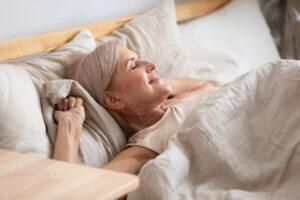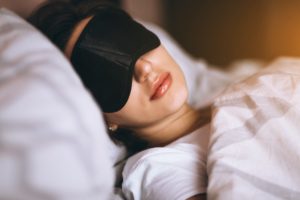Hypnic Headaches: Symptoms, Causes, and Relief
- A hypnic headache is one that wakes you up, typically in the middle of the night.
- Hypnic headaches feel like a dull or throbbing pain, depending on severity.
- This primary headache disorder is incredibly rare.
- If diagnosed, caffeine pills may be advised to help treat symptoms.
If you have ever been woken up by a headache in the middle of the night, you may have experienced what’s known as a hypnic headache. Hypnic headaches are considered rare, affecting fewer than 1% of people . If you are someone who has been diagnosed with this specific type of headache, you know that they can be extremely frustrating.
What Are Hypnic Headaches?
Hypnic headaches are a rare type of headache that occurs during sleep and wakes the person up, which is why they’ve earned the nickname “alarm-clock headaches“ . The pain can keep people up for at least 15 minutes, if not longer.
Hypnic headaches only occur while a person is sleeping . This timing distinguishes them from other types of headaches, such as migraines or cluster headaches , which may cause difficulty falling asleep but can occur at any time of day.
People who experience hypnic headaches typically have them several times a week. The onset of hypnic headache typically occurs after age 50 years, though a few cases younger than age 40 years have been reported.
Are Your Nighttime Headaches a Health Risk?
Answer three questions to understand if your nighttime groaning is a concern you should worry about.
What Are the Symptoms of a Hypnic Headache?
Symptoms of a hypnic headache can include :
- Dull or throbbing pain affecting one or both sides of the head
- Waking up in the middle of the night due to headache, multiple times a month
- Nausea
- Sensitivity to light or sounds
- Runny eyes or nose
The primary symptom of a hypnic headache is dull or throbbing head pain that occurs during sleep, multiple times per month, usually around the same time of night. Hypnic headaches can be unilateral or bilateral, which means they can affect one or both sides of your head. However, it’s more common for a hypnic headache to affect both sides.
Another distinguishing feature of hypnic headaches is that they usually occur in the middle of the night, or around two to three hours after falling asleep. They often occur around the same time and may even happen multiple times per night , lasting for 15 minutes to three hours. Hypnic headaches can range in severity, but they’re painful enough to rouse you from sleep.

What Causes a Hypnic Headache?
Hypnic headaches are considered a primary headache disorder, which means they are not caused by a known underlying condition. Hypnic headaches often occur during rapid eye movement (REM) sleep, so it’s possible that an area of the brain involved with processing pain gets activated, leading to a hypnic headache. Beyond that, researchers don’t know for sure what causes hypnic headaches.
Hypnic headaches may also be linked to melatonin production. Melatonin is a hormone that makes you feel sleepy, and its production levels rise and fall throughout the day in line with your sleep-wake cycle . Because hypnic headaches occur at the same time each night, some researchers believe there may be a disturbance to the underlying rhythms that regulate melatonin production, which causes lower melatonin levels and, subsequently, hypnic headaches.
Part of the evidence supporting this theory comes from the efficacy of lithium in treating hypnic headaches, since lithium is effective in treating other chronobiological disorders and helps increase melatonin levels.
Who Usually Gets Hypnic Headaches and Why?
Older adults and women are more likely to get hypnic headaches. Over 90% of people experience their first hypnic headache after age 50 , with an average age of onset of 62 years old. Women are between 1.5 to two times more likely to have hypnic headaches than men.
It usually takes a long time from onset of headaches to a diagnosis of hypnic headaches, which may skew the ages of those who have them to be older. On average, people don’t receive a diagnosis until seven years after their first hypnic headache. This is because various other more common causes of headache need to be considered first.
How Are Hypnic Headaches Diagnosed?
To diagnose hypnic headaches, your doctor will inquire about your symptoms and when they occur. This will help them determine whether your symptoms are caused by hypnic headaches or another condition that has similar symptoms. For example, high blood pressure, brain tumors, depression, and other sleep disorders like sleep apnea can also cause headaches that occur at night or wake you up from sleep.
To help rule out other conditions, your doctor may order tests such as a polysomnogram (an overnight sleep study), an MRI, or CT scans of your brain.
What Are the Treatments for Hypnic Headaches?
Caffeine is considered to be the most effective treatment for hypnic headaches. It sounds counterintuitive, but a caffeine pill can help people with hypnic headaches sleep reduce their symptoms. It also has relatively minimal side effects, especially when compared with other medications for hypnic headaches.
However, regular use of caffeine pills and pain relievers can lead to medication overuse headaches, a type of rebound headache caused by excessive use of medications. Always speak to your healthcare provider before taking new medications as they can recommend the right timing, dosage, and type of medication for your situation.
When Should I Talk to My Doctor?
Hypnic headaches are challenging to live with. They cause pain and deprive you of a full night’s sleep. Healthy sleep is essential to our mental performance, physical health, and emotional wellbeing.
If you find yourself regularly waking up with a headache, talk to your doctor. They can help you determine whether you have hypnic headaches or an underlying health condition. Once you have a treatment plan, you can start sleeping and feeling better.
Medical Disclaimer: The content on this page should not be taken as medical advice or used as a recommendation for any specific treatment or medication. Always consult your doctor before taking a new medication or changing your current treatment.

Still have questions? Ask our community!
Join our Sleep Care Community — a trusted hub of sleep health professionals, product specialists, and people just like you. Whether you need expert sleep advice for your insomnia or you’re searching for the perfect mattress, we’ve got you covered. Get personalized guidance from the experts who know sleep best.
References
9 Sources
-
Lanteri-Minet M. (2014). Hypnic headache. Headache, 54(9), 1556–1559.
https://pubmed.ncbi.nlm.nih.gov/25231430/ -
Evers, S., & Goadsby, P. J. (2005). Hypnic headache. Practical Neurology, 5(3), 144–149.
https://pn.bmj.com/content/5/3/144 -
Lanteri-Minet, M., & Donnet, A. (2010). Hypnic headache. Current Pain and Headache Reports, 14(4), 309–315.
https://pubmed.ncbi.nlm.nih.gov/20512536/ -
Holle, D., Naegel, S., & Obermann, M. (2013). Hypnic headache. Cephalalgia: An International Journal of Headache, 33(16), 1349–1357.
https://pubmed.ncbi.nlm.nih.gov/23832130/ -
Escudero Martínez, I., González-Oria, C., Bernal Sánchez-Arjona, M., & Jiménez Hernández, M. D. (2015). Description of series of 10 patients with hypnic headache: Discussion of the diagnostic criteria. Neurologia (Barcelona, Spain), 30(4), 195–200.
https://pubmed.ncbi.nlm.nih.gov/24953414/ -
Silva-Néto, R. P., Santos, P., & Peres, M. (2019). Hypnic headache: A review of 348 cases published from 1988 to 2018. Journal of the Neurological Sciences, 401, 103–109.
https://pubmed.ncbi.nlm.nih.gov/31075680/ -
American Academy of Sleep Medicine. (2014). The International Classification of Sleep Disorders – Third Edition (ICSD-3). Darien, IL.
https://aasm.org/ -
Cajochen, C., Kräuchi, K., & Wirz-Justice, A. (2003). Role of melatonin in the regulation of human circadian rhythms and sleep. Journal of Neuroendocrinology, 15(4), 432–437.
https://pubmed.ncbi.nlm.nih.gov/12622846/ -
Liang, J. F., & Wang, S. J. (2014). Hypnic headache: A review of clinical features, therapeutic options and outcomes. Cephalalgia: An International Journal of Headache, 34(10), 795–805.
https://pubmed.ncbi.nlm.nih.gov/24942086/

